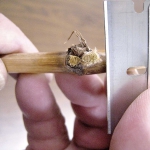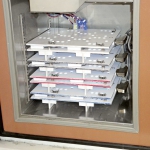A computer model developed by Washington State University is helping grape growers across the nation and on several continents better predict grapevine cold hardiness.
One of the limitations to growing juice and wine grape varieties in northern latitudes is cold temperature. Grape growers in the Pacific Northwest and other northern latitudes routinely experience reduced yields and even vine death due to low winter temperatures and late-spring and early-fall frosts.
Dormant grapevines have the ability to acclimate bud, cane, and trunk tissues to temperatures well below 15°F, but the vine’s tolerance to cold temperatures—known as cold hardiness—is highly variable and depends on site, microclimate, and variety.
“Cold is an issue here in Washington,” said Dr. Michelle Moyer, WSU Extension viticulture specialist. About every ten years or so, the region experiences a sub-Arctic blast in the winter, and cold temperatures have occurred early in the fall several times in the last four years.
By knowing the real-time critical temperatures for bud, phloem or xylem injury, growers can decide if wind machines will help prevent cold damage, Moyer says. Cold hardiness information is also useful in alerting growers to the need to assess bud or vine tissue damage before pruning.
In 1990, former WSU plant physiologist Dr. Robert Wample published a scientific article describing the university’s microcomputer-controlled freezing, data collection and analysis for cold hardiness evaluation. The technique measured cold hardiness by digital thermal analysis and used a special freezer and thermocouplers to capture the burst of heat produced when water or tissues freeze.
WSU scientists and engineers have since improved their techniques and now have nearly 30 years of data that can be used for developing models. From mid-October to mid-April, technicians collect weekly bud and vine tissue samples from mature grapevines grown at WSU’s Irrigated Agriculture and Research Center in Prosser, and from nearby commercial vineyards, and evaluate them for cold hardiness. Results are posted for free access at http://wine.wsu.edu/research-extension/weather/cold-hardiness/.
The cold hardiness information is provided as a service to industry by WSU and is partially funded by the Washington Wine Industry Foundation and the Washington State Concord Grape Research Council.
Prediction model
“Through the years, WSU scientists noticed that there was a pattern to the graphs,” Moyer told Good Fruit Grower. “If there’s a pattern, that means it can be modeled. And if we can model it, we can provide real-time monitoring and better predict damage from cold.”
John Ferguson, WSU engineer, worked with the decades of data to develop a grape cold-hardiness prediction model that uses daily temperature as the main input variable to drive daily changes in hardiness. The model currently simulates cold hardiness for 23 grape varieties with 89 to 99 percent accuracy. New varieties are being added to the model, but it takes several years of data before an addition can be made.
“You need weather data to get the model to work, which is where WSU’s AgWeatherNet system steps in,” said Moyer. AgWeatherNet is an automated weather station network administered by WSU.
Growers can tap into current and historical weather data collected by nearly 160 weather stations in the state. In addition to the cold hardiness model, the AgWeatherNet website contains other computer models for pests and diseases.
But not all growers are located near an AgWeatherNet station, and some may have their own weather stations, noted Moyer.
“That’s why we also developed a version of the model that can work from an Excel spreadsheet to calculate cold hardiness. To run the model, you can go to the AgWeatherNet website and find the nearest station to your vineyard or you can download the spreadsheet and hand enter your own weather data. It doesn’t have to be data from AgWeatherNet. It can be from any source that has daily minimum and maximum temperatures.”
Broad appeal
The model’s portability has broadened its impact beyond Washington borders.
Moyer has sent the cold hardiness model to more than 60 extension agents, growers, and other interested people in more than a dozen states, Canada, Germany, and Hungary.
She’s received feedback ranging from gratitude to fantastic to “good information we didn’t have before.”
“The model is designed to give growers a heads up for cold events like the one we had in mid-November,” Moyer said. “Even if you experience critical temperatures, vine damage is not instant because it takes time for the vine to respond. The model alerts you to potential damage.”
Moyer added that the model is a good indicator that further vine assessment is needed before pruning. “If you think you might have damage, you’ll want to wait until you are close to pruning time to cut buds and canes to assess damage.”
The AgWeatherNet model plots critical temperatures when 10, 50, and 90 percent of primary buds are killed. The Excel version of the model plots 50 percent bud damage.
Grapevines can survive more than 50 percent phloem damage, in some cases, and still be productive, provided the vines are properly cared for, she said. But when xylem becomes damaged, productivity and vine survival are questionable. •
ONLINE
To learn more or access the cold hardiness model, visit wine.wsu.edu/research-extension/weather/cold-hardiness/model
—————–
Cold hardiness and ripening
The need to bring grapes to full maturity rarely impacts cold acclimation or maximum hardiness of the vines, say Washington State University researchers.
Past research has been inconclusive in answering the question of whether the need to develop and fully ripen a crop adversely influences a vine’s cold acclimation rate or the ability to acquire cold hardiness.
“Grapevines know when it’s time to harden off for winter,” said Dr. Markus Keller, Washington State University viticulturist. “Our study demonstrated that on vines that are not overcropped, extended hang time won’t hurt the plant.”
The four-year study of Cabernet Sauvignon grapes found that crop load or extended hang time—within commercially acceptable levels—rarely impacts cold acclimation and maximum mid-winter cold hardiness in arid western regions of the United States.
The study entitled “Fruit Ripening Has Little Influence on Grapevine Cold Acclimation,” was authored by Keller and Lynn Mills of WSU and Dr. Mercy Olmstead of the University of Florida and published in 2014 in the American Journal of Enology and Viticulture.
Cabernet Sauvignon was selected because the variety requires a long ripening period and is slow to acclimate to cold temperatures. Data were collected from 2005 to 2008 from three harvest-time treatments: all clusters removed at fruit set; all clusters removed at veraison; and all clusters removed at leaf fall after the first killing frost (average yield three to four tons per acre).
The study concluded that only sporadic gains of 2° to 4°F in bud hardiness and 2°F in xylem hardiness resulted from the drastic treatment of removing all clusters after fruit set or at veraison compared to letting the crop hang until leaf fall, which represented extended hang time.
“On most measurement dates, such early crop removal failed to enhance cold hardiness,” the researchers reported.
Grapevines in eastern Washington where the study was conducted appear to be able to adjust in-season leaf activity to meet whole plant demand to ripen fruit and contribute to vine and bud cold acclimation, according to the study.
Cool temperatures in autumn favor cold acclimation, regardless of whether or not the vines are simultaneously ripening a crop, the report said. However, the authors are careful to point out it is unclear if the findings apply to vines cropped heavier than four tons per acre or in regions with much cooler or shorter growing seasons, low light intensity, or high soil water status.








Leave A Comment